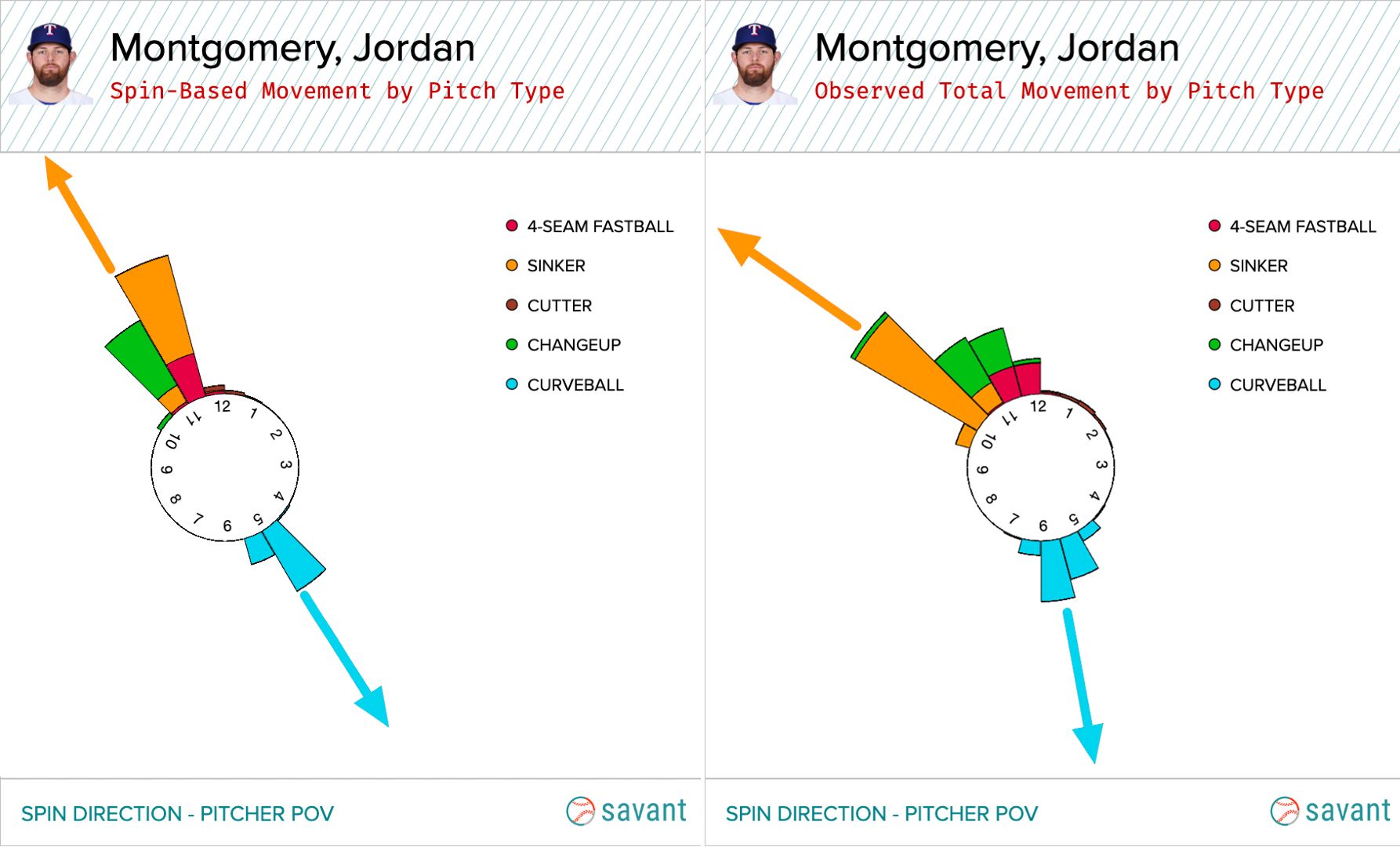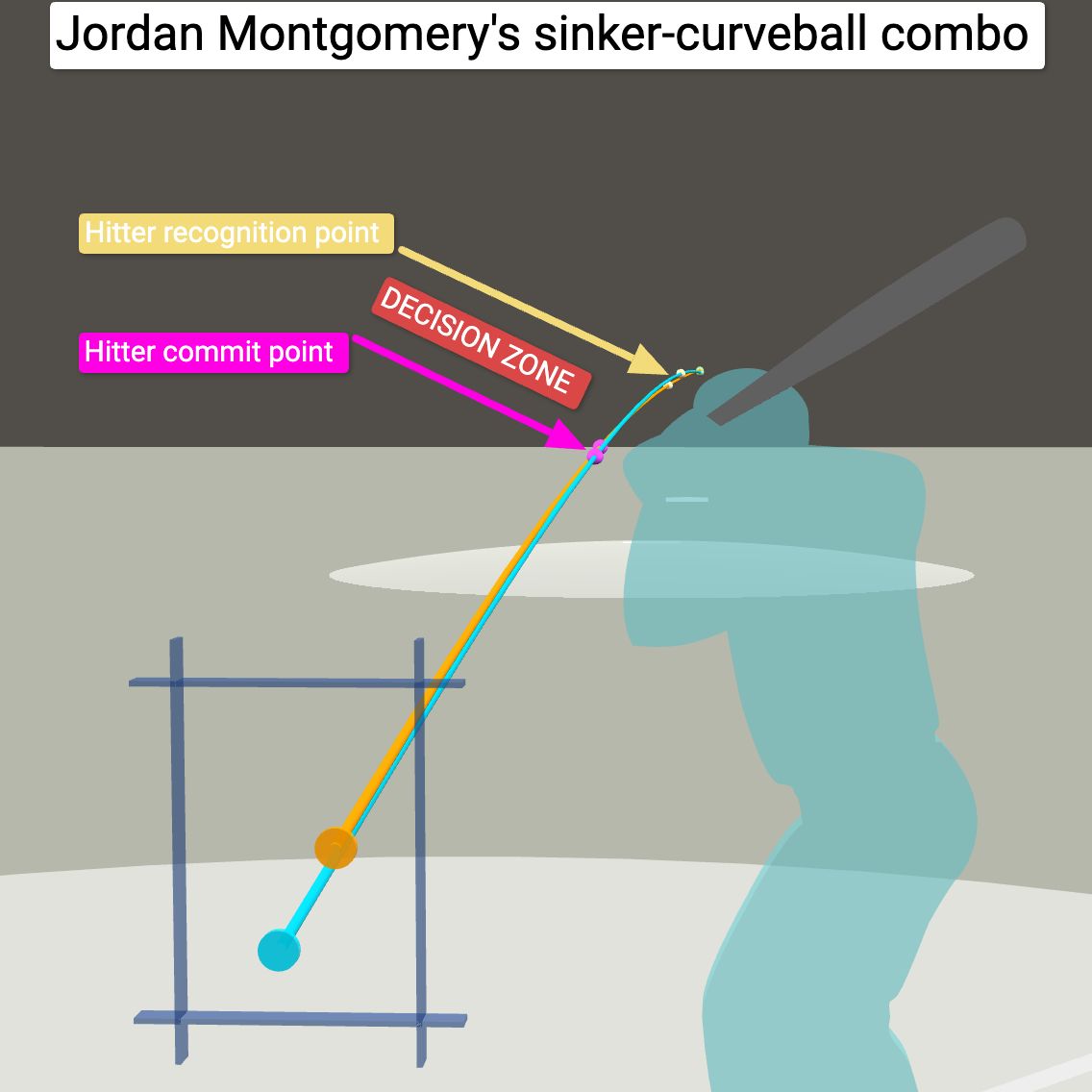Blake Snell is the reigning Cy Young Award winner. Yoshinobu Yamamoto is the reigning winner of Japan's version of the Cy Young. But the third top starting pitcher remaining on the free-agent market just made his case on MLB's biggest stage.
Jordan Montgomery's emergence as the ace of the Rangers' World Series run vaulted his stock at the perfect time, and for good reason. The 30-year-old left-hander, who was just named to the All-MLB Second Team, has proven himself to be one of the most reliable southpaws around.
Here are the three things that made Montgomery such a valuable arm for Texas in the playoffs -- and will make him such a valuable arm for whatever starting rotation he joins next season.
1) He leads hitters into a House of Mirrors
Montgomery throws five pitches -- four-seam fastball, sinker, cutter, curveball, changeup -- but it was a two-pitch combo that made him a postseason star: sinker-curveball.
Those are the go-to weapons against elite hitters. When Montgomery struck out Yordan Alvarez three times in Game 1 of the ALCS, for example, he used almost exclusively his sinker and curveball to do it.
Montgomery's sinker-curveball combo is extremely effective despite lacking elite characteristics from a "stuff" perspective; both pitches have fairly ordinary velocity, spin and movement. So how does he get so many hitters out, especially the likes of Alvarez?
One big key is how his sinker and curveball mirror each other. In other words: When he releases them, they spin in perfectly opposite directions. That creates extra deception for a hitter -- it makes it harder to distinguish the two pitch types from one another. And a fastball-curveball combo is one of the most conducive to "spin mirroring." Pitchers like Shane Bieber have used this technique to great effect.
Here's the spin axis of Montgomery's different pitch types, as tracked by Statcast, shown from the pitcher's point of view.

The easiest way to visualize how the ball comes out of Montgomery's hand is by picturing the face of a clock. Montgomery's sinker rotates in the "11:00" direction -- some backspin, some side-spin toward his arm side. His curveball rotates in the "5:00" direction, directly on the opposite side of the clock -- it tumbles down and toward his glove side.
On top of how the sinker and curveball spin out of Montgomery's hand, there's an added layer of deception in their trajectory as they get to the hitter. Montgomery's sinker and curveball actually diverge more on the way to the plate than the hitter would expect. His sinker ends up with extra arm-side run -- it averages just over 15 inches of horizontal break -- while his curveball ends up dropping more straight down than the hitter would judge (it averages only three inches of horizontal break).
That's what the "observed movement" chart on the right represents in contrast to the "spin-based movement" on the left. When Montgomery releases his sinker and curveball, they look the same because of spin mirroring. By the time they reach the batter, their movement has taken them to very different locations.
Here's what it looks like in action. Below is a slow-mo of Montgomery releasing his sinker vs. his curveball, from the ALCS against the Astros. Because the two pitches are spinning as perfect opposites -- and coming from an extremely consistent release point, another of Montgomery's strengths -- they're very difficult to recognize before it's too late.
That means even a hitter of Alvarez's caliber will have trouble telling Montgomery's sinker and curveball apart, as ESPN's Jeff Passan detailed in a breakdown of how Montgomery used pitch tunneling to get the better of Alvarez and the Astros in the postseason. Montgomery's consistency in tunneling his two best pitches on the biggest stage certainly bodes well for his ability to continue to get hitters out with his new team.

2) He changed his plan of attack to become a playoff ace
That sinker-curveball combo is something Montgomery had to learn how to master in Texas. He was not deploying his repertoire in the same way before he got to the Rangers.
Montgomery is always primarily a sinker-curveball pitcher against left-handed hitters, but against righties, that was not the case for most of the season. With the Cardinals, and even when he first got traded to the Rangers, Montgomery was using his changeup as his No. 2 pitch to right-handed hitters.
It was only down the stretch in September that he turned to his curve as his chief secondary offering, a trend that continued in the playoffs.
Montgomery vs. RHB in 2023
Through August: 42% sinkers, 28% changeups, 20% curveballs
September: 37% sinkers, 29% curveballs, 19% changeups
Postseason: 32% curveballs, 30% sinkers, 16% changeups
(Note: Montgomery also throws some four-seamers and cutters to RHB, not shown here)
When Montgomery was on top of his game in the playoffs, he was using his curveball and sinker basically evenly. He'll probably balance out his pitch mix again to get through a full regular season -- work in more changeups, four-seamers and cutters -- but it's good to know that Montgomery can home in on his best stuff when the moment matters most.
He's built up his sinker over the years for it to become that trustworthy primary weapon. In the early part of his career with the Yankees, Montgomery used both his sinker and four-seamer often. He was always a solid starter with that balanced arsenal in New York, too. But over the last couple of seasons, his sinker has taken over -- which makes sense, since his four-seamer has never been much of an overpowering, swing-and-miss fastball, and his sinker is really the only pitch in his arsenal that generates significant movement.
Montgomery's 43% sinker usage in 2023 was a career high for a full season. He's even added a tick or two of velocity from the start of his career to now. Montgomery's 93.3 mph average sinker velo this year was a career best.
3) He controls the zone
Montgomery has one other quality that makes him so reliable: He's highly effective at pitching in the strike zone.
That's what lets him chug along through 30-plus starts and 150-plus innings every year, always with an ERA in the mid-3s and 150-plus strikeouts (Montgomery's checked all those boxes for the last three seasons in a row). He does a lot more than just strike out hitters on curveballs down in the dirt.
Statcast's run value metric lets us look at how good Montgomery's been within the zone. Run value takes the result of every pitch a pitcher throws and uses that to tally up how many runs he's prevented for his team.
On pitches in the strike zone, Montgomery was worth +43 runs prevented in 2023, combining his regular season and postseason success. That was a top-10 mark in the Majors, and it was the second year in a row Montgomery posted excellent in-zone numbers (he was worth +34 runs prevented in the strike zone in 2022).
Pitchers with highest in-zone run value in 2023
Regular and postseason combined
- Gerrit Cole: +65 runs prevented
- Blake Snell: +56 runs prevented
- Sonny Gray: +53 runs prevented
- Zac Gallen: +49 runs prevented
- Kodai Senga: +49 runs prevented
- Kyle Bradish: +48 runs prevented
- Cristian Javier: +46 runs prevented
- Corbin Burnes: +45 runs prevented
- Zack Wheeler: +44 runs prevented
- Jordan Montgomery: +43 runs prevented
It's no coincidence that the two Cy Young Award winners are at the top of that leaderboard. A pitcher has to be good in the zone if he wants to be a dependable workhorse. That's what Montgomery has become, and that's what he should continue to be in 2024.
